Ficus trees are generally a great starter plant for beginners and wannabe gardening enthusiasts due to their low maintenance and growth requirements. Currently, there are over 800 known fig tree species, but not all serve gardening purposes.
Best types of ficus trees include the following outdoor figs: common fig, Indian laurel, mistletoe fig, sacred fig, as well as the following indoor figs: audrey ficus, creeping fig, ficus daniella, fiddle-leaf fig, narrow-leafed fig, rubber plant, and weeping fig.
To know more about the types of ficus trees, their appearance, how to take care of them, as well as ways of pruning and propagating ficus trees, simply read further this article!
What Is a Ficus Tree?
Ficus trees are a member of the Moraceae family, which comprises trees, vines, or shrubs that produce mostly inedible fruits called figs. They are mostly tropical plants but can be grown successfully as houseplants and planted outdoors.
What Does a Ficus Tree Look Like?
All species vary in appearance—some may have leaves that are narrow or thick, small or long, coarse or leathery-textured, and can be a variety of shapes such as almond, violin, or rounded as well as colors such as green, yellow, brown, and purple.
Some species may have drooping branches. Their trunks are usually gray or brown in color.
How to Identify a Ficus Tree?
It depends on the species, but generally, ficus trees usually grow mulberry or pear-shaped fruits, accompanied by small, inconspicuous flowers that are typically green in color.
What Are the Uses and Benefits of Ficus Trees?
Ficus trees can be used for landscaping purposes and as indoor ornamental trees. They can also be utilized for their medicinal properties.
Outdoor Ficus Trees
Common Fig
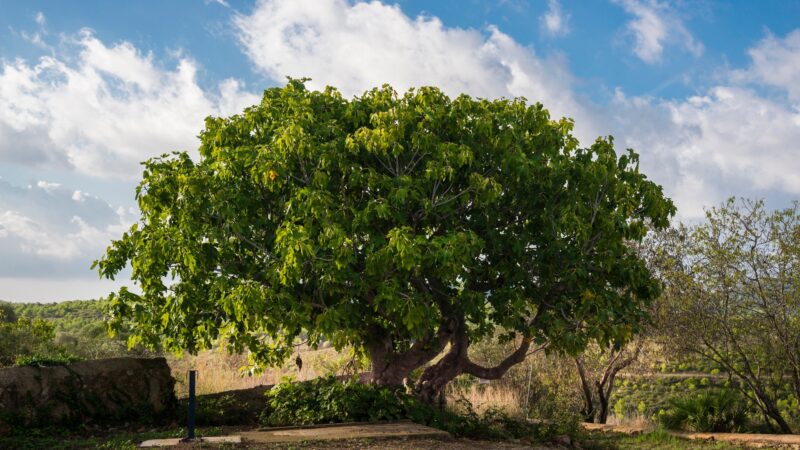
This species originates from Western Asia and was cultivated during 5,000 BCE in the Mediterranean. Today, it grows in most subtropical areas worldwide. Its fruits serve a variety of purposes, such as baking ingredients, coffee substitute, and wine, while its wood can be used to create fuel, small articles, and boxes.
- Scientific Name: Ficus carica
- Appearance: Grows as either a large shrub or a small, low-growing deciduous tree. It has large and thick leaves that are vibrant green in color, as well as small, inconspicuous flowers. Its pear-shaped fruits can be purplish-brown, yellowish-green, or bronze in color with silver bark.
- Size: 10 to 15 feet (shrub), 15 to 50 feet (tree)
- Care Guide:
- Grows best in well-drained soils that are organically rich and sufficiently moist under full sun or part shade.
- In colder areas, adding root mulch can retain soil moisture, while using frames or clear plastic sheets can protect the plant during winter.
- In the growing season, regularly water the plant, then reduce as fall approaches. If grown in containers, bring it inside during the winter season.
- When pruning, do so early in the summer when the fruit is ripe enough. If the tree is damaged due to frost, prune any wood as soon as it begins regrowing in bush form.
Indian Laurel
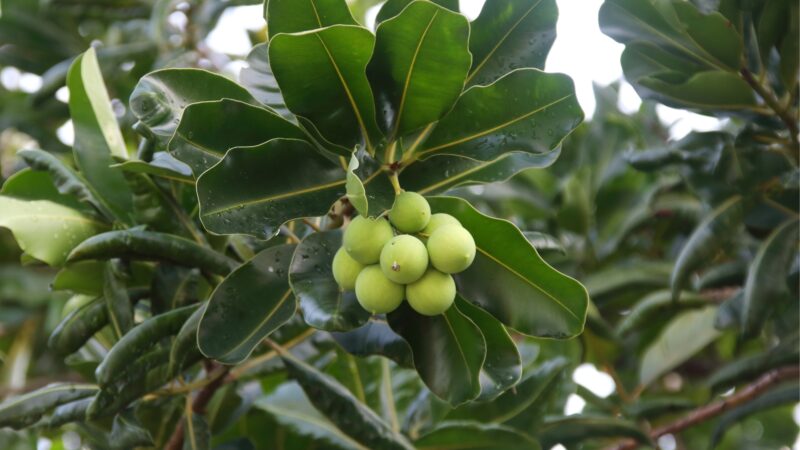
Also known as the Chinese banyan, this fig species has a history of taxonomic confusion since its scientific name has changed several times in the last decades.
It is primarily used for landscape design, such as in interior malls, large courtyards, upscale resorts, wide medians, and residential estates, but can also be used as a bonsai plant.
- Scientific Name: Ficus microcarpa
- Appearance: A soft-wooded evergreen tree with lustrous oval-shaped leaves, thin branches and trunk, and smooth grayish-white bark. It has a small and inconspicuous flower, as well as small, rounded fruit that’s yellowish-green, brownish, or reddish in color.
- Size: Up to 40 feet
- Care Guide:
- Soil should be sandy, loamy, or shallow rocky and must be well-drained, as well as partially shaded or under full sunlight. It grows best when it’s propagated by either air layering or vegetative cutting.
- Regularly water as it needs consistent moisture and 70 to 100 percent humidity to achieve optimum growth.
- When grown as propagated cuttings, the plant must be pruned and staked regularly to maintain a good appearance.
- Encourage deep rooting and deep watering practices when planting around paved areas since the Indian laurel can grow an extensive system of roots.
Mistletoe Fig
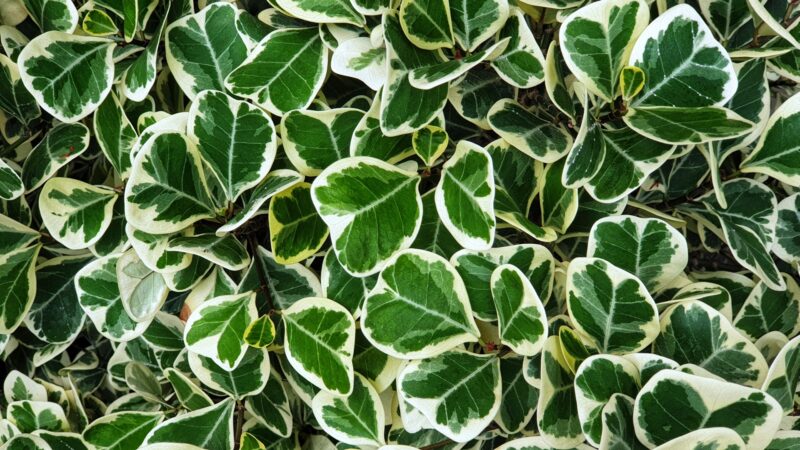
Native to the Malayan archipelago before it was introduced worldwide, the Mistletoe Fig is the only ficus species capable of bearing fruit when planted indoors.
It is usually used as an ornamental plant and is usually called the Golden Mistletoe Fig due to its attractive leaves. Additionally, it also has anti-diabetic properties.
- Scientific Name: Ficus deltoidea
- Appearance: Grows as either a small tree or a large, evergreen shrub with a grayish-white bark. Its leathery leaves are spoon or deltoid in shape with reddish or yellowish undersides, while its round or oblong-shaped fruits are greenish-white when unripe and mature to an orange or red color when ripe.
- Size: 5 to 15 feet
- Care Guide:
- This species prefers moderate to full sunlight, little to moderate water, medium relative humidity, and slightly dry soil.
- Since this plant grows in tropical climates, it is recommended to plant it indoors in places with cooler climates. However, it still has to be placed outside during the spring and summer seasons.
- Regular pinching and trimming are needed for tropical and subtropical areas throughout the entire year.
- If used as a bonsai, repotting is necessary every 4 to 5 years when its roots have filled the pot. Do so in the middle of the summer season. Make sure to prune the roots less than or equal to one-fourth of the tree’s total root mass.
Sacred Fig
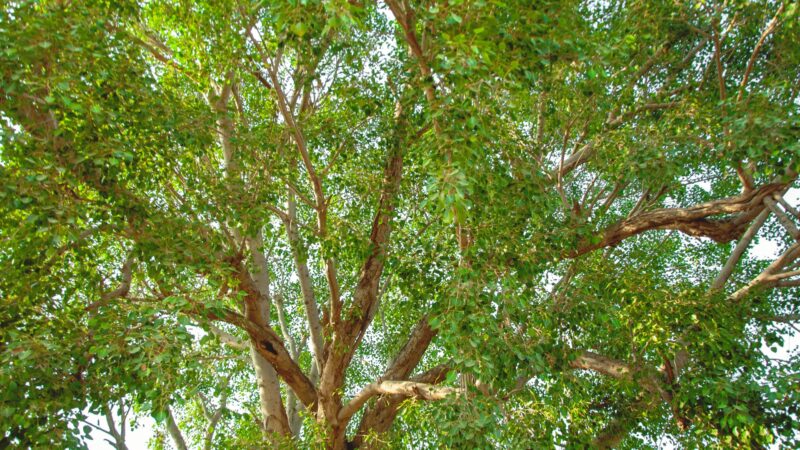
Holding a sacred and historically significant symbolism in Buddhism, it is often observed grown on the grounds of Buddhist temples, especially in Hawaii.
It usually starts its life by growing itself on a host tree or occasionally on wall cracks. The Sacred Fig is also used as alternative medicine, treating dysentery, urinary ailments, wart removal, and healing gum diseases.
- Scientific Name: Ficus religiosa
- Appearance: Grows as a large semi-evergreen or deciduous tree with brown bark and thin and leathery heart-shaped leaves. Its figs are green when beginning to grow and purple when it ripens.
- Size: Up to 100 feet
- Care Guide:
- Usually propagated by air layering, cuttings, or tissue cultures. It grows easily in a controlled greenhouse environment. The seeds are highly sensitive to moisture retention.
- Optimum requirements are partial shade to full sun exposure, loamy or sandy soil, and little watering once it has well-developed roots.
- Once the plant has established itself, apply fertilizer only during the spring and summer seasons, then stop during fall and winter.
- Prune regularly since its main branches grow fairly quickly. Do so when it reaches a height of 60 centimeters, then another time once it grows to 80 centimeters. Afterwards, prune only when necessary (e.g., when the tree grows too many branches).
Indoor Ficus Trees
Audrey Ficus
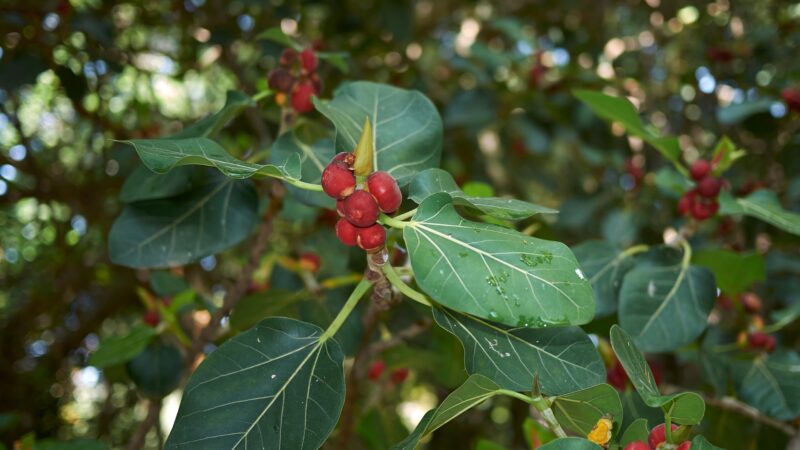
Native to India and Pakistan, this ficus tree is also considered sacred under Buddhism and generally thrives in rainforests but can be often seen around Buddhist temples.
It is also used for landscaping along streets or in gardens, timber for furniture and well-curbs, and in alternative medicine to treat illnesses such as liver inflammation, syphilis, and dysentery.
- Scientific Name: Ficus Benghalensis
- Appearance: A very large, soft-wooded evergreen tree capable of producing long surface roots when mature. It also has a large trunk flare, oval-shaped and leathery leaves that are bronzy red when immature and green to olive green when mature, small and reddish fruits, and inconspicuous pairs.
- Size: Up to 50 feet
- Care Guide:
- Usually propagated through stem-cutting, seeds, air layering, or transplanting.
- Requires full sunlight exposure, regular watering, sufficiently moist soil, and intervals of drought in between waterings.
- If grown inside a container, the plant should be well-drained to avoid humidity from accumulating beneath the container.
- As much as possible, use a slow-release fertilizer and organic potting mix so you wouldn’t need to fertilize during the first 6 months of its life.
- When pruning, elevate the canopy base for better visibility. Avoid thinning out the crown of the tree since it’s highly sensitive to sunscald.
Creeping Fig
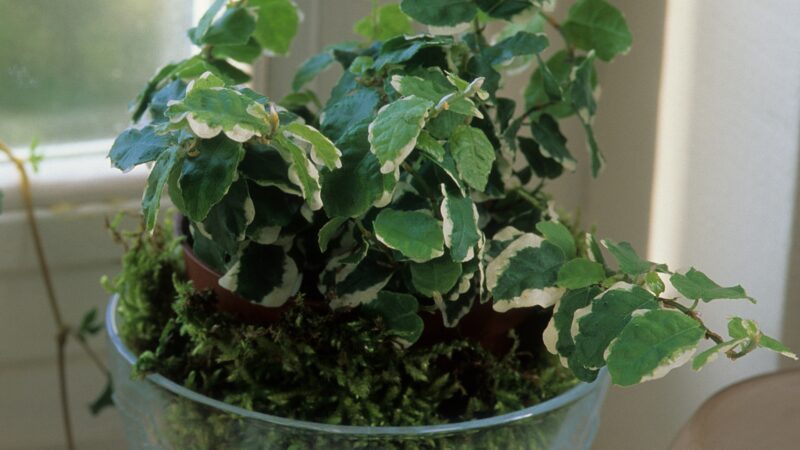
An aggressive-growing vine that can cover up to 5,000 square feet of space, the Creeping Fig is usually used for interiorscapes such as in terrariums, hanging baskets, and pseudo-topiaries.
However, it is usually observed as covers for walls, trellis, fences, and gateways as it can easily attach to any brick, concrete, or metal surfaces.
- Scientific Name: Ficus pumila
- Appearance: A woody evergreen vine with small, heart-shaped leaves that are dark green on its upper surface and pale on its lower surface. Its flowers are small and greenish-yellow in color, while its round fruit is green to brown; both are only seen on adult leaves.
- Size: Up to 40 feet
- Care Guide:
- The plant prefers shade to partial sunlight exposure and regular irrigation since it is not tolerant to drought, high levels of humidity, and well-drained soil.
- When growing indoors, plant in a soil-based potting mix. When growing outdoors, make sure it is planted in well-drained soil that is sufficiently moist. To reduce winter damage, plant it in a location that provides protection against the sun and drying winds.
- Prune vigorously to control its spread. If you grow it as a ground cover near a building or wall, clip its edges quickly and regularly. Avoid planting it on the walls of your home since it can potentially damage wooden structures.
Banana-Leaf Fig
Native to China, India, and Southeast Asia, the Banana Leaf Fig is an evergreen tree typically grown as an interior plant in regions with temperate climates.
It is also used as an ornamental tree in parks and gardens. Usually, the plant is also referred to as the Alii ficus since the Alii cultivar is the most popular among gardening enthusiasts.
- Scientific Name: Ficus maclellandii
- Appearance: Strangling fig with slender aerial roots, thick and leathery leaves that are oval, oblong, lance, or slightly ovate in shape, tiny white flowers, and round fruits that are yellow to red in color.
- Size: 6 to 10 feet (indoors), up to 82 feet (outdoors)
- Care Guide:
- Grows best with bright but indirect lighting, above-average relative humidity, and moist soils with good drainage. Water only when the upper 1 to 2 inches of the soil is dry.
- Fertilize twice a year during its growing period using a houseplant-labeled fertilizer, although all-purpose fertilizer and organic mulch can also work.
- Since this plant commonly experiences root rot, take the plant out of its pot and regularly inspect its roots. If they are brown and mushy, remove the affected roots. Rinse the remaining healthy sections with lukewarm water, then clean the pot using soapy water.
- If needed, you can prune to achieve the size you desire. Otherwise, it is unnecessary.
Fiddle-Leaf Fig

This finicky, slow-growing ficus tree is commonly grown as a houseplant since it is an ideally striking ornament in office spaces, living rooms, and other interiors.
Fiddle-leaf figs are native to the tropical rainforests of Western Africa and are characterized by their full, luscious appearance, which propelled them into popularity among gardening enthusiasts.
- Scientific Name: Ficus lyrata
- Appearance: Small-sized tree when grown indoors but tall once it is planted outside or in high-ceiling places. Its leaves are leathery, oval, and semi-lobed, resembling a fiddle, hence its name. It also grows round, reddish fruits, and inconspicuous flowers.
- Size: Up to 10 feet (indoors), up to 60 feet (outdoors)
- Care Guide:
- Requires dry soil (preferably sandy, clay, or loamy), partial shade to full sun exposure, regular watering with good drainage, and medium relative humidity.
- Propagate it using a 6-inch stem tip cutting or through air layering.
- Feed with a general houseplant fertilizer at least once or twice annually. Do so once during the spring, then another time in the summer.
- When grooming, simply mist its leaves with water and wipe any dust and dirt with a soft cloth. Trim leaf margins that have become brown in color and remove any dropped and dead leaves.
- As much as possible, avoid pruning unless its growth is well-developed. Pinch the new growth off fiddle-leaf branch edges to allow a bushier and thicker growth. Wipe any of its milky-white sap that oozes out from the cuts.
- Keep away from the reach of pets and children, as this is a toxic plant.
Narrow-Leafed Fig
This tropical ficus tree is easy to grow as a container plant indoors and in greenhouses. It usually grows in forests (rainforests, freshwater swamp forests, lowland forests) found in its native distribution in Borneo, Java, Peninsular Malaysia, Singapore, and Sumatra. It can be used as a feature tree in cooler areas and a shade tree in warmer areas.
- Scientific Name: Ficus binnendijkii
- Appearance: Medium-sized evergreen tree with glossy and narrow-pointed leaves, a thin and flexible trunk that ranges from dark brown to light gray, arching branches, small and red fruit, inconspicuous flowers that are green in coloration, and weepy branches.
- Size: 8 to 13 feet (indoors), 20 to 100 feet (outdoors)
- Care Guide:
- Prefers loamy, moist, and well-drained soil under fully sunlit areas. It can also grow in partially shaded areas but growth will be significantly slower.
- When growing indoors, it is recommended to place it around 2 to 3 meters away from the window. However, if the light is too bright, protect the plant by shading it.
- Lightly spray once a week during the spring season and wipe the leaves, as well using a wet sponge.
- Repot the plant during spring or summer yearly in its first few years of growth. Afterwards, you can repot once every 4 to 5 years.
- Feed with liquid fertilizer, alternating between organic and mineral, once every two weeks.
- Pruning is unnecessary except when the plant has developed long or high stems.
Rubber Plant
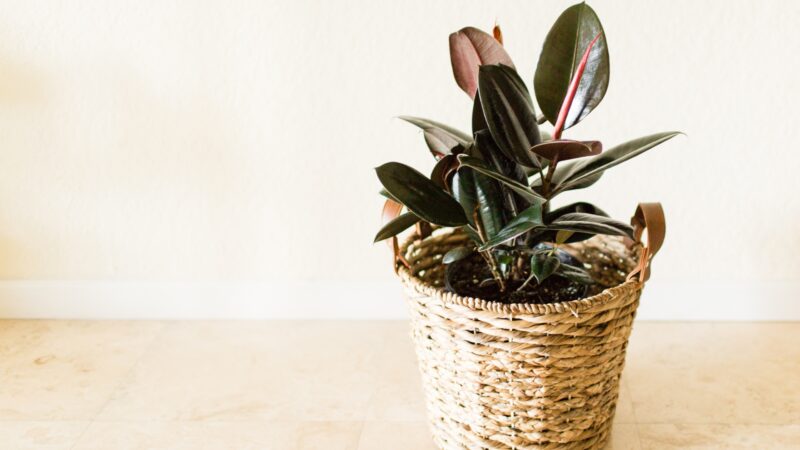
Popularly used as an interior container plant, the Rubber tree is an ideal introductory plant to gardening since it’s relatively easy to take care of.
It can also be used as a foundation tree found in large atriums, courtyards, buildings, and residential estate entryways, as it serves as a bold, coarse-textured accent plant.
- Scientific Name: Ficus elastica
- Appearance: Tall ornamental plant with large, thick, and glossy leaves that are evergreen, deep maroon, or marked with cream, yellow, white, or pink, as well as a smooth, brown bark. Its fruit is egg-shaped and greenish-yellow in color, while its flower is small and green.
- Size: 6 to 10 feet (indoors), up to 100 feet (outdoors)
- Care Guide:
- Prefers medium to high light exposure, medium relative humidity, dry soil, and a well-drained container when planted indoors.
- Propagates best through air layering and layered with sphagnum moss. It can also be propagated using stem or tip cuttings.
- Regularly fertilizer using a water-soluble houseplant fertilizer once every two weeks during its active growth phase in the spring and summer seasons.
- Since the plant tends to grow tall and lanky since the branches are droopy, you can try supporting the plant using a stake or pruning it during the spring season.
- Mist the leaves with water when they get dusty to keep them attractive and maintain overall plant health.
- Pruning is necessary if you want the scaffold branches to be durable. Do so while the plant is young. Once it has matured, take extra care in pruning since it’s prone to sunscald injury.
Weeping Fig
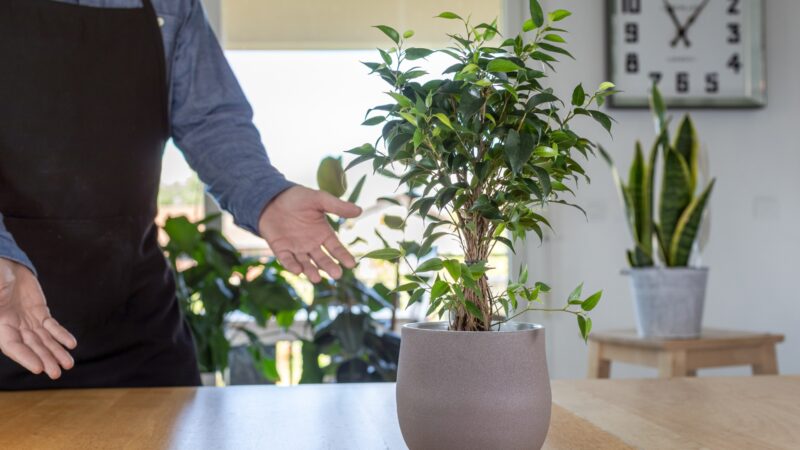
Due to its attractive appearance, resilience against even poor environmental conditions, and low maintenance, the Weeping Fig is a popular houseplant native to Australia and Southeastern Asia. It can be used as a screen, clipped hedge, topiary, and as accent plant on entryways and patios.
- Scientific Name: Ficus benjamina
- Appearance: Has thick and shiny evergreen leaves with long and droopy branches, smooth pale brown to gray bark, non-showy flowers, and round-shaped fruits that are orange, yellow, or dark red in color.
- Size: 2 to 10 feet (indoors), 40 to 50 feet (outdoors)
- Care Guide:
- Develops best in soil-based potting mix placed under bright but indirect or curtain-covered sun exposure but can also survive in partial shade. It also needs sufficient water and medium to high relative humidity.
- Propagate the plant at any given season by air layering. If you want to go with cuttings, do so in the summer season.
- Prune lightly during late autumn to early winter, especially when the plant is young so that it grows relatively strong branches.
- Feed once every 1 to 2 months during its growing season using a liquid fertilizer. Be wary of excessive feeding, as it can adversely affect plant growth.
- Repot in the late winter or early spring if the roots become overcrowded. Use general-purpose potting soil afterwards.
How to Take Care of a Ficus Tree?
How to Care for a Ficus Tree Indoors?
- Place your ficus tree in indirect or curtain-filtered full sunlight or partial shade, depending on the species requirements. If the humidity is high, they can handle direct sunlight.
- Use a potting mix made out of 1 part of each of the following: potting soil or garden loam and peat moss, and sand, peat moss, and pine bark.
- During times of low growth and in the winter season, slightly dry out the soil in between waterings and make sure the plant is not waterlogged by draining excess water. If your plant is placed on top of a saucer, regularly drain the saucer. During this period, fertilizer is unnecessary.
- During the summer season when its growth is active, keep the soil sufficiently moist. Use houseplant liquid or water-soluble fertilizer as directed by the product label.
- When deciding where to place your ficus tree with indoor plants, place them close together to create a living environment with higher amounts of relative humidity. If necessary, you can use a humidifier.
- Spray water on the leaves using a mist bottle or wash using a wet sponge every few weeks or when there is a noticeable amount of dust on your plant. Use this opportunity to check if there are any pests, such as scales and spider mites often found on the underside of the leaves.
- Prune depends on the requirements of the ficus tree species. Some may need pruning during their youth to allow the growth of sturdier branches, while some don’t even need pruning unless you’re controlling their size.
- Repot when the plant has been growing well.
How to Care for a Ficus Plant Outdoors?
- Place in an area that is not directly shone by the sun. However, some species can tolerate up to 6 hours of direct sunlight. Plant near buildings on east and south sun exposures. Generally, ficus trees need well-drained loamy, or sandy soil with medium fertility, but it depends on the species.
- When transplanting outdoors, allow your ficus plant to acclimatize to its new surroundings. Water weekly, then reduces once the plant has adjusted, preferably twice a year only (once in the spring and summer).
- Fertilization should occur only in its active growing phase, specifically during the summer season. Use a balanced fertilizer such as half a cup of 10-10-10.
- Some species may not do well during the winter. If you’re growing the plant in a container, place it indoors to avoid frost injuries. However, if you’re growing it on outdoor sil, spread a thick layer of mulch around the base of the plant.
- Prune when necessary, such as when they are young, when you want to train the plant in becoming a topiary, or when the branches are too long. Otherwise, you can prune according to the size you desire. When doing so, elevate the canopy base.
How to Propagate a Ficus Tree?
Air Layering. Using a knife, cut around the stem that is 12 to 18 inches from the plant’s shoot tip. Make sure to penetrate down to its woody center.
Remove the bark, scrape and place rooting hormone and moist sphagnum moss on the exposed stem surface. Secure the stem with clear plastic and tie. Once the roots develop after several weeks, cut the stem off below the tie and plant in potting soil.
Cuttings. Either select a small section of the stem and the plant tip or a leaf joint and 2 to 3 inches of the stem, then remove any lower foliage near the base. Treat with rooting hormone, then insert the bare part of the cuttings onto your rooting medium.
How to Prune a Ficus Tree?
Choose a branch that is at least a third of the diameter of the entire branch being cut. Make the cut outside its collar to reduce the risk of damaging the remaining section of the tree.
Once the tree has the proportions you desire, prune the remaining twigs until they are back into bud formation. Most ficus trees do not require pruning, but it depends on the species.